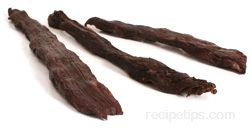Loading
Biltong
A type of dried meat that is processed in long strips and preserved for consumption in South Africa. Somewhat similar to beef jerky or charki, Biltong is made primarily from cuts of meat taken from a beef rump, or the meat of wild game such as deer or from ostrich meat. The outside of the beef has the same hardened texture of jerky however, the Biltong is thicker and not as stiff or chewy as jerky, exposing a deep red interior that has a softer consistency. Biltong is produced by cutting thick strips and slabs of meat either across the grain or with the grain of the muscle. Depending on the size of the meat cut being processed into Biltong, the grain direction is taken into consideration when cutting the pieces for drying. Smaller pieces for home consumption can be prepared or larger and longer cuts of meat can also be prepared from which smaller individual servings are cut. Long narrow strips of Biltong are most often cut with the grain while larger flat pieces of Biltong are cut across the grain. After being sliced, as much of the sinew or silverskin that can be removed is taken off and discarded. The meat is then salted, dipped in undiluted vinegar for tenderizing, and seasoned with spices such as pepper and coriander. After being dipped and seasoned, the Biltong is dried by hanging it out overnight in the cool air, or by placing it in wooden drying boxes, or by using chilling rooms such as the larger producers of Biltong would use for preparing greater quantities of this product. Bitlong is very similar to Italian bresaola or slinzega.
There currently aren't any reviews or comments for this term. Be the first!
Advertisement
Advertisement








